伊瓜苏瀑布的三火枪瀑布, 阿根廷 Three Musketeers Falls at Iguazú Falls, Argentina (© Mark Meredith/Getty Images)
伊瓜苏瀑布的三火枪瀑布, 阿根廷 Three Musketeers Falls at Iguazú Falls, Argentina (© Mark Meredith/Getty Images)
奔流不息,为你为我 All for falls and falls for all
伊瓜苏瀑布的三火枪瀑布, 阿根廷
没有任何声音能盖过伊瓜苏瀑布的轰鸣。但令人震撼的不仅是那轰鸣的声浪。这座横跨阿根廷与巴西边境的自然奇观,以其磅礴气势令人无法抗拒。广阔的瀑布群绵延近两英里,汇聚了270多道独立瀑布,每一处都展现出独特的水流奔腾和水雾蒸腾之景。
今日图片展示的是阿根廷一侧的壮观景观三火枪瀑布。三股强劲水流并肩倾泻入伊瓜苏河,四周被郁郁葱葱的亚热带雨林环绕。有趣的是,虽然这些瀑布位于阿根廷境内,却只能从巴西一侧看到并进入。
瀑布属于伊瓜苏国家公园,这里是联合国教科文组织认定的世界遗产地,致力于保护该地区丰富的生物多样性,并为游客修建了步道与栈道,方便全景观赏与近距离感受那雷鸣般的水势。打开你的感官去感受大自然的奇观,同时别忘了回馈它的慷慨:不留下痕迹,只带走美好记忆。
Three Musketeers Falls at Iguazú Falls, Argentina
No voice is loud enough to drown out the roar of Iguazú Falls. But it's not just the sound. The sheer presence of this natural wonder is overwhelming as it straddles the border between Argentina and Brazil. This vast waterfall system stretches nearly 2 miles and features more than 270 individual cascades, each offering a unique display of tumbling water and shimmering mist.
Today's image captures one of the spectacular sights on the Argentine side—the Three Musketeers Falls, a trio of powerful streams plunging side by side into the Iguazú River below, framed by lush subtropical rainforest. Interestingly, although the falls are located in Argentina, they are only visible and accessible from the Brazilian side.
The falls are part of Iguazú National Park, a UNESCO World Heritage Site that protects the region's rich biodiversity and offers visitors a network of trails and catwalks for panoramic views and close-up encounters with the thundering water. Open your senses to nature's wonders—and return its generosity. Leave no trace and take only memories with you.
宪法火车站,布宜诺斯艾利斯,阿根廷 Constitución railway station, Buenos Aires, Argentina (© Grafissimo/Getty Images)

宪法火车站,布宜诺斯艾利斯,阿根廷 Constitución railway station, Buenos Aires, Argentina (© Grafissimo/Getty Images)
具有纪念意义的火车站 The rise of a republic
阿根廷的独立纪念日
今天是阿根廷的独立日。这片拥有辽阔潘帕斯草原、丰富文化遗产与鲜明民族认同的南美国家,于1816年在图库曼省圣米格尔市正式宣告独立,摆脱西班牙的殖民统治。通往独立的道路充满挑战,伴随着长期内战与政治动荡;而阿根廷的独立运动也深受美国和法国独立运动的影响。最终,阿根廷人民以坚定不移的意志赢得了国家的自由。
独立之后,阿根廷逐步构建现代国家体系。1853年,该国颁布了第一部宪法,为后来的民主制度奠定了法律基础,这部宪法至今仍影响着国家政治运作。在文化和体育领域,阿根廷也在全球舞台上留下了深刻印记:文学巨匠豪尔赫·路易斯·博尔赫斯的作品影响深远;阿萨多(阿根廷传统烧烤)体现了其深厚的饮食文化;而像迭戈·马拉多纳与莱昂内尔·梅西这样的世界级足球运动员更是国家精神的象征。今日图片中的布宜诺斯艾利斯的宪法火车站,是该国重要的铁路交通枢纽,象征着国家发展、互联互通的精神,也是那个变革年代所孕育出的团结意志的缩影。
Independence Day of the Argentine Republic
Argentina, a nation of sweeping pampas, rich culture, and a bold identity, celebrates its Independence Day today. This pivotal date marks the moment in 1816 when delegates from across the region gathered in the city of San Miguel de Tucumán to declare freedom from Spanish colonial rule. The road to independence was not easy; it followed years of internal struggles and revolutions influenced by global movements, including the American and French revolutions. But the resolve of the Argentine people prevailed.
Since gaining independence, Argentina has taken important steps in shaping its national identity. The drafting of its first constitution in 1853 established a framework for democratic governance that continues to influence its political system. The country has also made notable contributions to global culture and sports. It has offered the world literary figures like Jorge Luis Borges, a rich culinary tradition centered on asado (a traditional barbecue), and legendary athletes such as Diego Maradona and Lionel Messi. Constitución railway station in Buenos Aires, pictured here, is a historic hub that reflects Argentina's drive for growth, connectivity, and the spirit of unity that emerged during a transformative era.
阿根廷和巴西边境的伊瓜苏瀑布 Iguazu Falls at the border of Argentina and Brazil (© AirPano LLC/Amazing Aerial Agency)
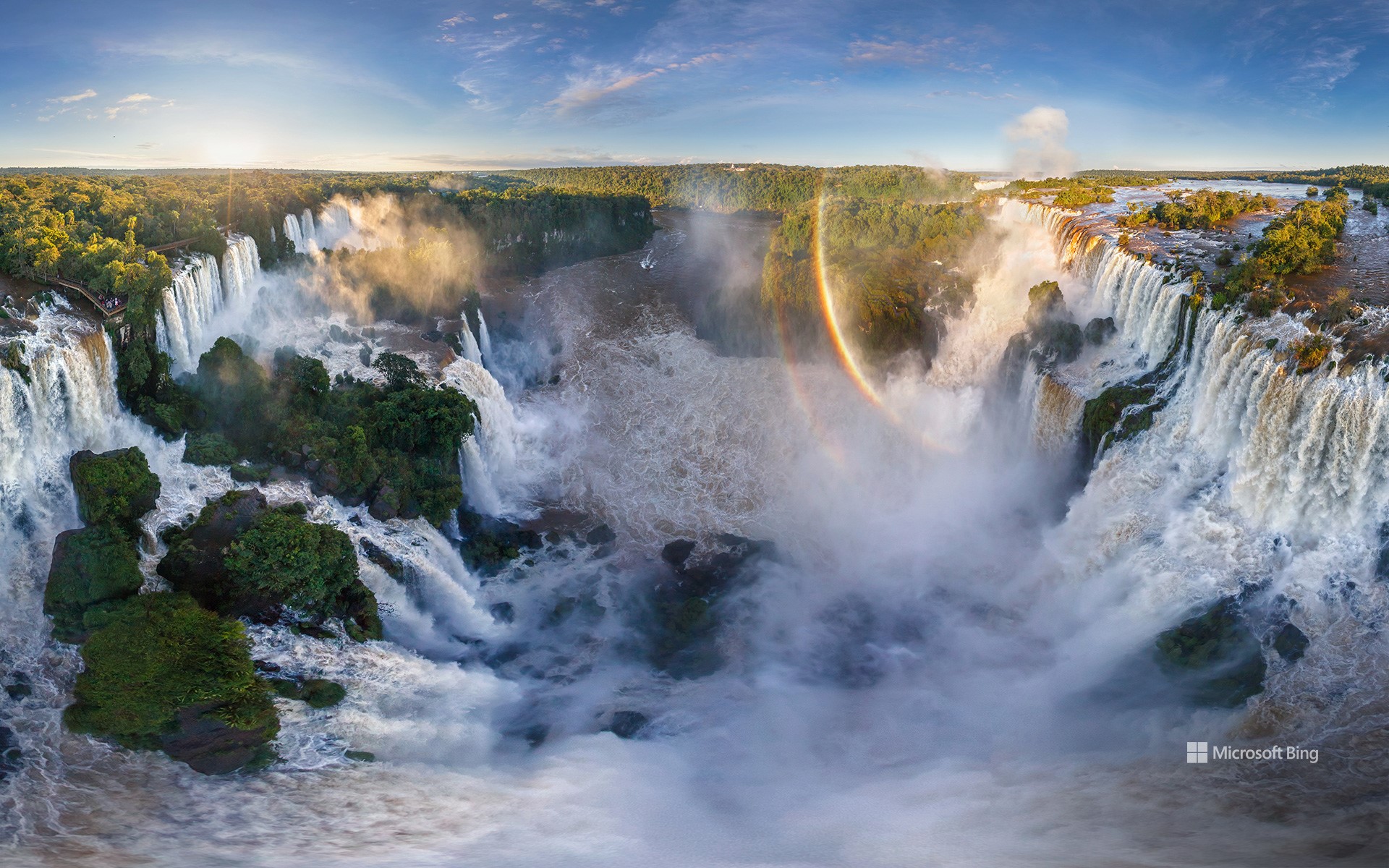
阿根廷和巴西边境的伊瓜苏瀑布 Iguazu Falls at the border of Argentina and Brazil (© AirPano LLC/Amazing Aerial Agency)
“大水”中的彩虹波 Rainbow waves in 'big water'
阿根廷和巴西边境的伊瓜苏瀑布
想亲眼目睹让尼亚加拉瀑布都望尘莫及的壮观瀑布吗?让我们走进世界上最大的瀑布群——伊瓜苏瀑布。“伊瓜苏”这个名字来源于瓜拉尼语或图皮语,意思是“大水”。这些瀑布群由伊瓜苏河形成,位于阿根廷米西奥内斯省和巴西巴拉那州的交界处。它们拥有独特的阶梯状结构,是由三层玄武岩形成的两级阶梯式瀑布,非常引人注目。
在这些瀑布成为我们今天所熟知的旅游胜地之前,它们经历了一段相当漫长的旅程。西班牙探险家阿尔瓦·努涅斯·卡韦萨·德·巴卡可能是第一个看到这些瀑布的欧洲人。1917年,商人多明戈·阿亚拉加雷看到了这个地区的潜力,并建造了酒店和道路。随后,这个瀑布群成为了一个热门的旅游胜地。于是在1934年,阿根廷建立了伊瓜苏国家公园。在1939年,巴西也建立了伊瓜苏国家公园。联合国教科文组织分别在1984年和1986年将这两个国家公园列为世界遗产,并认定它们具有“杰出的普遍价值”。
Iguazu Falls at the border of Argentina and Brazil
Welcome to Iguazu Falls, the largest waterfall system in the world. The name 'Iguazu' has its origins in the regional languages Guarani or Tupi, meaning 'big water.' These epic waterfalls are formed by the Iguazu River, on the border of Argentina's Misiones province and Brazil's Paraná state.
The Iguazu Falls have long attracted admirers. Spanish explorer Alvar Núñez Cabeza de Vaca is thought to have been the first European to see them in 1541. In 1907, businessman Domingo Ayarragaray saw their potential and built a hotel and roads nearby. The falls became such a sensation that they were designated as national parks in both countries—Argentina's Iguazu National Park in 1934 and Brazil's Iguaçu National Park in 1939. UNESCO made the parks World Heritage Sites in 1984 and 1986, respectively. Surrounded by the rainforest, the falls are made up of hundreds of cascades and channels carved over millions of years by the Iguazu River, the tallest of which is the U-shaped Devil's Throat, at 269 feet high.
阿根廷拉里奥哈省塔兰帕亚国家公园 Talampaya National Park, La Rioja province, Argentina (© Gonzalo Azumendi/Getty Images)
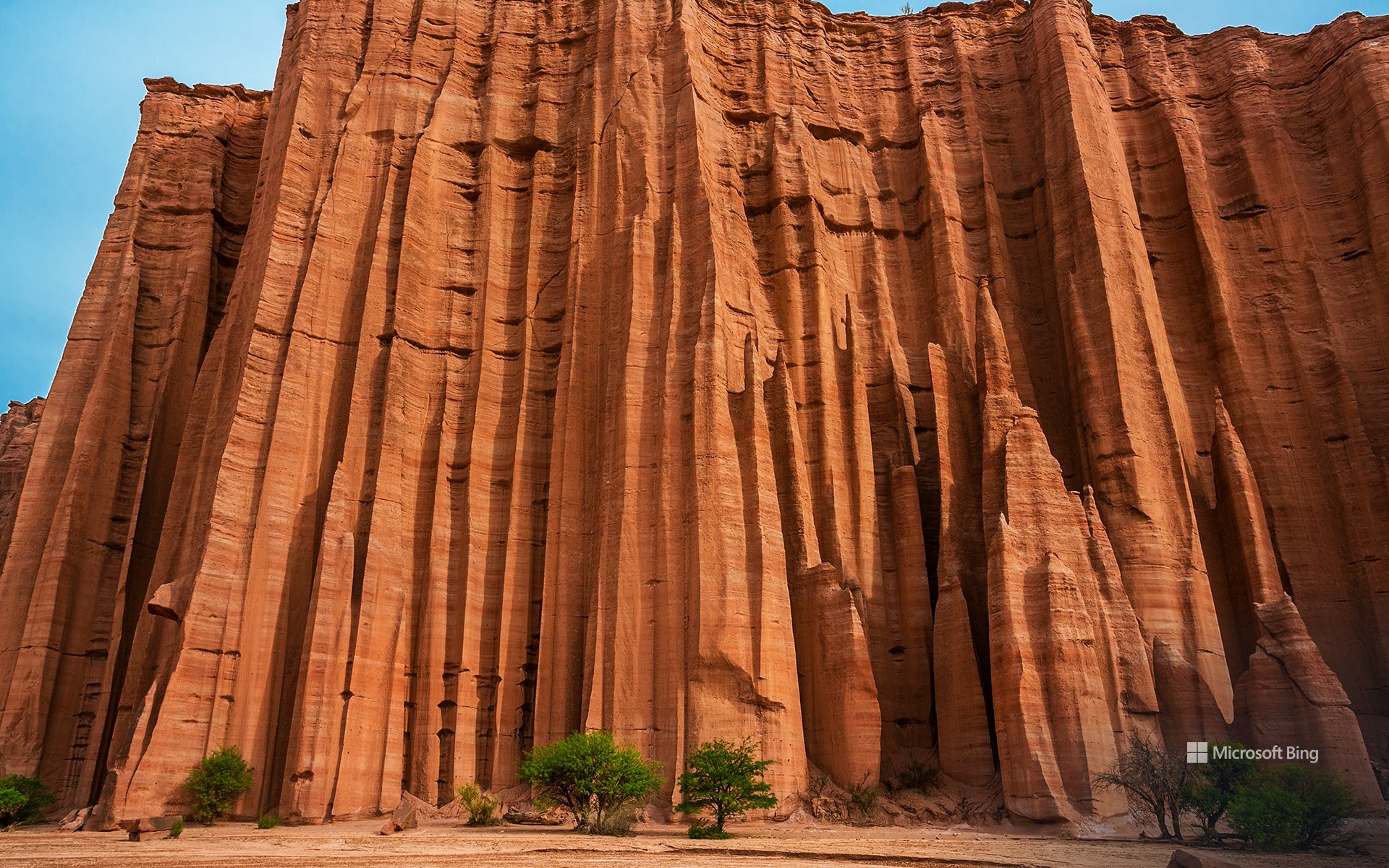
阿根廷拉里奥哈省塔兰帕亚国家公园 Talampaya National Park, La Rioja province, Argentina (© Gonzalo Azumendi/Getty Images)
千仞高壁 Feeling 'sedimental'?
阿根廷塔兰帕亚国家公园
今天是阿根廷独立日,塔兰帕亚国家公园邀请我们走进这个国家古老的心脏地带。它坐落在拉里奥哈省,占地830平方英里,是联合国教科文组织认定的世界遗产。公园里,红色的岩层高耸入云,海拔高达469英尺,上面还刻有史前生命的秘密。这里发现过迄今为止最古老的恐龙化石,还有神秘的岩画展示出古老的艺术。公园的悬崖和洞穴上有西恩纳加人、迪亚吉塔人和其他土著文明创造的岩画,他们曾在公元3世纪至9世纪居住在该地区。此外,当地的植物(如耐旱的灌木和仙人掌)和动物则展现了大自然的美丽。原驼、野兔和狐狸在土地上自由漫步,秃鹰、白喉沙雀和沙色窜鸟在天空翩翩起舞。野性的大自然在召唤你,邀请你到塔兰帕亚国家公园探险。
Talampaya National Park, Argentina
As Argentina celebrates Independence Day, Talampaya National Park invites us to venture into the country's ancient heart. Here, towering red rock formations reach skyward, and cliffs and caves feature petroglyphs created by the Ciénaga, Diaguita, and other Indigenous cultures more than 1,000 years ago. This 830-square-mile park in La Rioja province is also home to some of the oldest dinosaur remains ever found. Moreover, nature's beauty is shown in the local flora, like xeric shrubs and cactus, and fauna. Guanacos, hares, and foxes roam free, while condors, white-throated cacholotes, and sandy gallitos grace the skies above this UNESCO World Heritage Site.
布宜诺斯艾利斯哥伦布剧院,阿根廷 Teatro Colón in Buenos Aires, Argentina (© Wei Hao Ho/Alamy Stock Photo)

布宜诺斯艾利斯哥伦布剧院,阿根廷 Teatro Colón in Buenos Aires, Argentina (© Wei Hao Ho/Alamy Stock Photo)
戏剧成为关注的焦点 Theater takes center stage
世界戏剧日
今天,整个世界都是一个大舞台。每年的3月27日,世界戏剧日都会在雷鸣般的掌声中拉开帷幕,为戏剧这个数百年来一直影响着大众的艺术形式奏响颂歌。世界戏剧日旨在推广戏剧,引起人们对戏剧艺术的重视,共享戏剧艺术给人类带来的精神财富。今天图中所见的是布宜诺斯艾利斯的哥伦布剧院,它是阿根廷丰富戏剧遗产的象征。这座剧院建于1908年,以其宏伟的建筑和卓越的音响效果而闻名,是世界上首屈一指的歌剧院。多年来,这里举办了许多传奇人物的演出,如恩里科·卡鲁索、理查·施特劳斯、莉丽·庞斯、玛丽娜·德·加巴林、乔斯·史东、布兰福德·马萨利斯等。在这个专属于戏剧的日子里,让我们一起欣赏这种以最壮观的方式讲述故事的艺术形式!
World Theater Day
Today, all the world's a stage. Every year on March 27, the curtains rise to thunderous applause in celebration of World Theater Day—an ode to an art form that has influenced the masses for centuries. The day aims to promote theater and raise awareness of how it has preserved ancient cultures, provided social commentary throughout history, and even helped form our language. Seen in the image today is the Teatro Colón, Buenos Aires, a symbol of Argentina's rich theatrical heritage. Built in 1908, the theater is renowned for its grand architecture and exceptional acoustics, making it one of the world's premier opera houses. Over the years, it has hosted performances by legendary figures such as Enrico Caruso, Richard Strauss, Lily Pons, Marina de Gabaráin, Joss Stone, Branford Marsalis, and many more. On this day dedicated to drama, let's appreciate this art form that continues to narrate stories in the most spectacular way!
原驼,冰川国家公园,阿根廷 Guanacos in Los Glaciares National Park, Patagonia, Argentina (© Yva Momatiuk and John Eastcott/Minden Pictures)
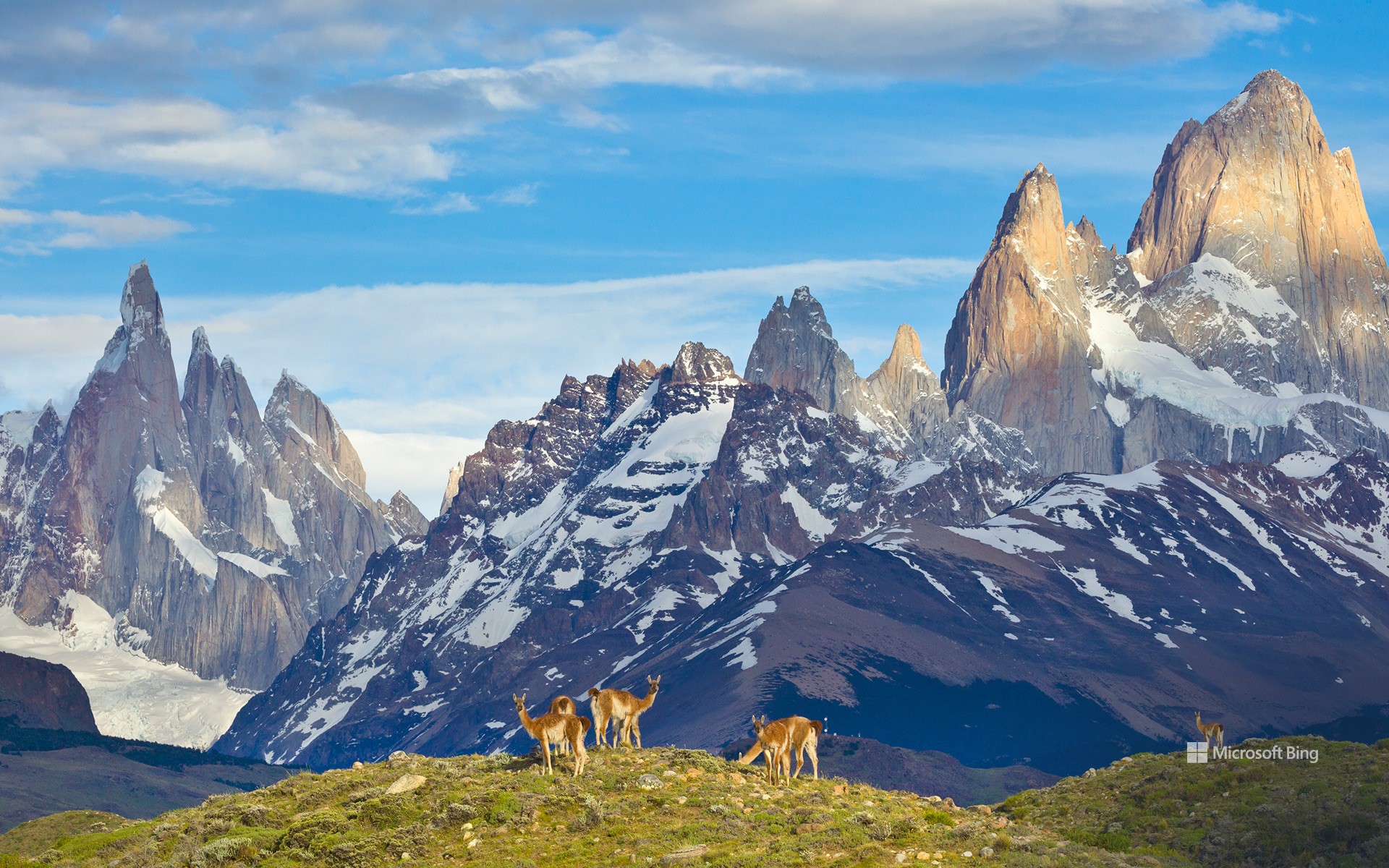
原驼,冰川国家公园,阿根廷 Guanacos in Los Glaciares National Park, Patagonia, Argentina (© Yva Momatiuk and John Eastcott/Minden Pictures)
出逃的美洲鸵 Llamas on the loose
国家美洲驼日
穿上登山鞋出门吧,因为今天是国家美洲驼日!12月9日是专门用来欣赏这些聪明且可驯化的动物的日子。您需要到安第斯山脉去看看它们那被称为原驼的野生表亲。据说,原驼起源于约4000万年前的北美中部平原。不过,它们逐渐迁移到了南美洲,在公元前4500年左右被驯化,并获得了美洲鸵的称号。
在今天的图片中,展示了在阿根廷的洛斯格拉兹阿勒冰川国家公园内自由漫步的原驼,它们有着深肉桂色的羊毛和卡通般的面孔。尽管它们外表可爱,但有时也会带点粗鲁在身上:原驼和美洲驼都会通过吐口水来维护自己在种群中的统治地位和阻止同类的入侵。不过,不要因此而放弃参加有组织的美洲驼徒步旅行,它们可是很棒的伙伴!
National Llama Day
Strap on your hiking boots because it's National Llama Day! December 9 is a designated day to appreciate these intelligent and trainable creatures. You'll need to visit the Andes Mountains to see their wild cousins, guanacos. Guanacos are believed to have originated in the central plains of North America 40 million years ago, but they gradually migrated to South America. Scientists think llamas descended from guanacos and were first domesticated around 4500 BCE.
As seen in today's image, guanacos are often spotted roaming free in Los Glaciares National Park, Argentina, sporting dark cinnamon-colored wool and cartoonish-looking faces. Cute as they are, they can be a bit rude: Both guanacos and llamas defend themselves by spitting to assert dominance within their herd or to keep intrusive peers at bay. Don't let this deter you from going on an organized llama trek though—they can make for great pack animal companions!
在新湾潜水的南露脊鲸,阿根廷瓦尔德斯半岛 Southern right whale diving in the Golfo Nuevo near the Valdes Peninsula, Argentina (© Gabriel Rojo/Minden Pictures)
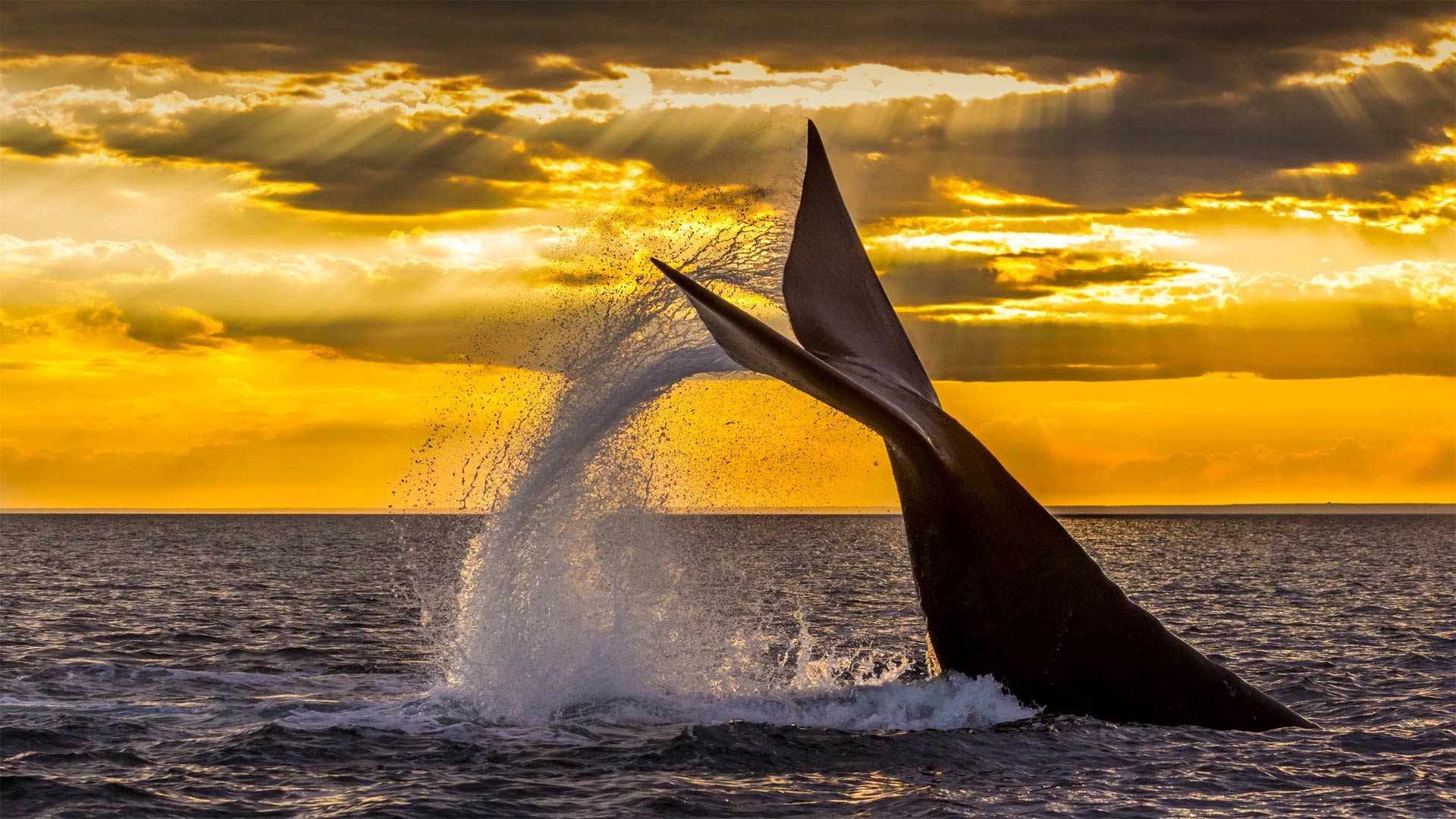
在新湾潜水的南露脊鲸,阿根廷瓦尔德斯半岛 Southern right whale diving in the Golfo Nuevo near the Valdes Peninsula, Argentina (© Gabriel Rojo/Minden Pictures)
南冰洋里的巨鲸 Giants of the Southern Ocean
Southern right whale
The end of September in the Southern Hemisphere means warming weather and the nearing of summer. For southern right whales like this one off the coast of Argentina, this means a transit southward toward Antarctica and rich feeding grounds. Southern right whales are a subspecies of right whale that inhabit the oceans below the equator. They feed on krill at the surface of the water, holding their mouths open as they swim through clouds of the tiny crustaceans.
Right whales got their names because they were the 'right' whale to hunt, desirable to whalers because they were relatively slow and floated when they died. Right whales are easily identifiable by the thick white calluses on their heads. They tend to be social and curious creatures and have been known to have close encounters with humans. They spend winters in warmer waters closer to the equator. The whale featured today surfaced off the Valdes Peninsula, home to the largest breeding population in the world, and a fitting location for the Southern Whale Natural Monument, created in 1984. In these protected waters, thousands of whales will mate and give birth, staying until October or November, when they will begin their great migration south.
南露脊鲸
南半球的9月底意味着气候变暖和夏季临近。对于阿根廷海岸外的这种南露脊鲸来说,这意味着向南迁移到南极洲和丰富的觅食地。南方露脊鲸是露脊鲸的一个亚种,栖息在赤道以下的海洋中。它们以水面上的磷虾为食,在穿过微小甲壳动物云层时张大嘴巴。
露脊鲸之所以得名,是因为它们是捕鲸的“正确”鲸鱼,捕鲸者之所以喜欢露脊鲸,是因为露脊鲸的速度相对较慢,死后会浮在水面上。露脊鲸头上厚厚的白色胼胝很容易辨认出来。它们往往是社会性和好奇的动物,并且已知与人类有密切接触。它们在靠近赤道的温暖水域过冬。今天,这头鲸鱼在巴尔德斯半岛浮出水面,这里是世界上最大的繁殖种群所在地,也是1984年建立的南方鲸鱼自然纪念碑的合适地点。在这些受保护的水域中,数千头鲸鱼将交配并产子,一直呆到10月或11月,届时它们将开始大规模向南迁徙。
阿根廷圣克鲁斯的洛斯马诺斯洞穴 Cueva de las Manos (Cave of the Hands) in Santa Cruz, Argentina (© Adwo/Alamy)
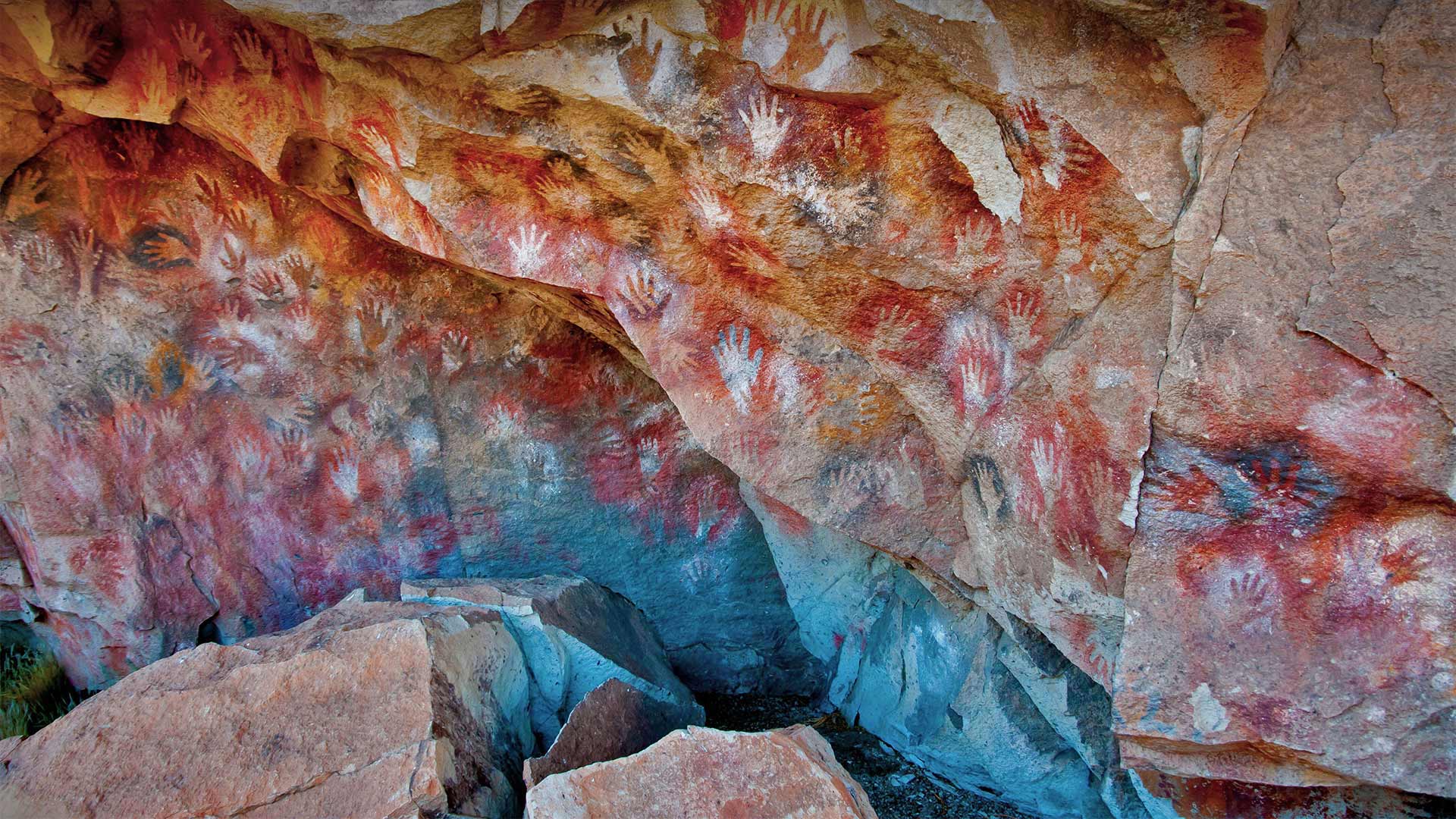
阿根廷圣克鲁斯的洛斯马诺斯洞穴 Cueva de las Manos (Cave of the Hands) in Santa Cruz, Argentina (© Adwo/Alamy)
9000年前的手印 9,000-year-old handprints
International Day of the World's Indigenous Peoples
What at first glance appears to be graffiti tagged on a rock wall is, in fact, artwork created by the first human settlers of this remote region deep in Argentine Patagonia. It's thought that the cave paintings were made between 13,000 and 9,500 years ago. The archaeological site is known in Spanish as the Cueva de las Manos (Cave of the Hands). It's the largest display of prehistoric handprints in the world, made all those years ago by people holding a hand against the rock wall and blowing pigments through tubes made of bone. Of the 829 black, white, red, and ochre prints, most are of young male hands. One print has six fingers, and only 31 are of right hands.
The cave paintings were created in at least three waves over thousands of years by ancestors of the Tehuelche people. Archaeologists have hypothesized that the artists were hunter-gatherers. This theory is supported by the fact that even older than the handprints are depictions of guanacos (a relative of the llama, and the main source of food at the time); rheas (large flightless birds); and hunting scenes.
Today, more than 370 million Indigenous people live in various regions of the world, like the Teheulche, who continue to live in Patagonia near the southern border between Argentina and Chile. To honor and protect the rights of the world's current Indigenous populations, the UN marks each August 7 as International Day of the World's Indigenous Peoples. We'll raise our hands in support of that.
世界土著人民国际日
乍一看,岩壁上的涂鸦标记实际上是阿根廷巴塔哥尼亚这个偏远地区的第一批人类定居者创作的艺术品。据认为,这些洞穴壁画是在13000年至9500年前绘制的。该考古遗址在西班牙语中被称为Cueva de las Manos(手洞)。这是世界上最大规模的史前手印展示会,多年前,人们用手抵着岩壁,用骨头制成的管子吹颜料。在829张黑、白、红和赭色的照片中,大多数是年轻男性的手。一个指纹有六个手指,只有31个是右手的。
这些洞穴壁画是特韦尔奇人的祖先在数千年中至少三次创作的。考古学家假设这些艺术家是狩猎采集者。这一理论得到了以下事实的支持:比手印更古老的是美洲驼(美洲驼的亲戚,当时的主要食物来源)的描述;大型不会飞的鸟类;还有狩猎场面。
今天,有3.7亿多土著人生活在世界各地,如特霍尔切人,他们继续生活在阿根廷和智利南部边界附近的巴塔哥尼亚。为了尊重和保护当今世界土著居民的权利,联合国每年8月7日都将其定为世界土著人民国际日。我们将举手表示支持。
冰川国家公园中的佩里托莫雷诺冰川,阿根廷 Perito Moreno Glacier in Patagonia's Los Glaciares National Park, Argentina (© Juergen Schonnop/Getty Images)
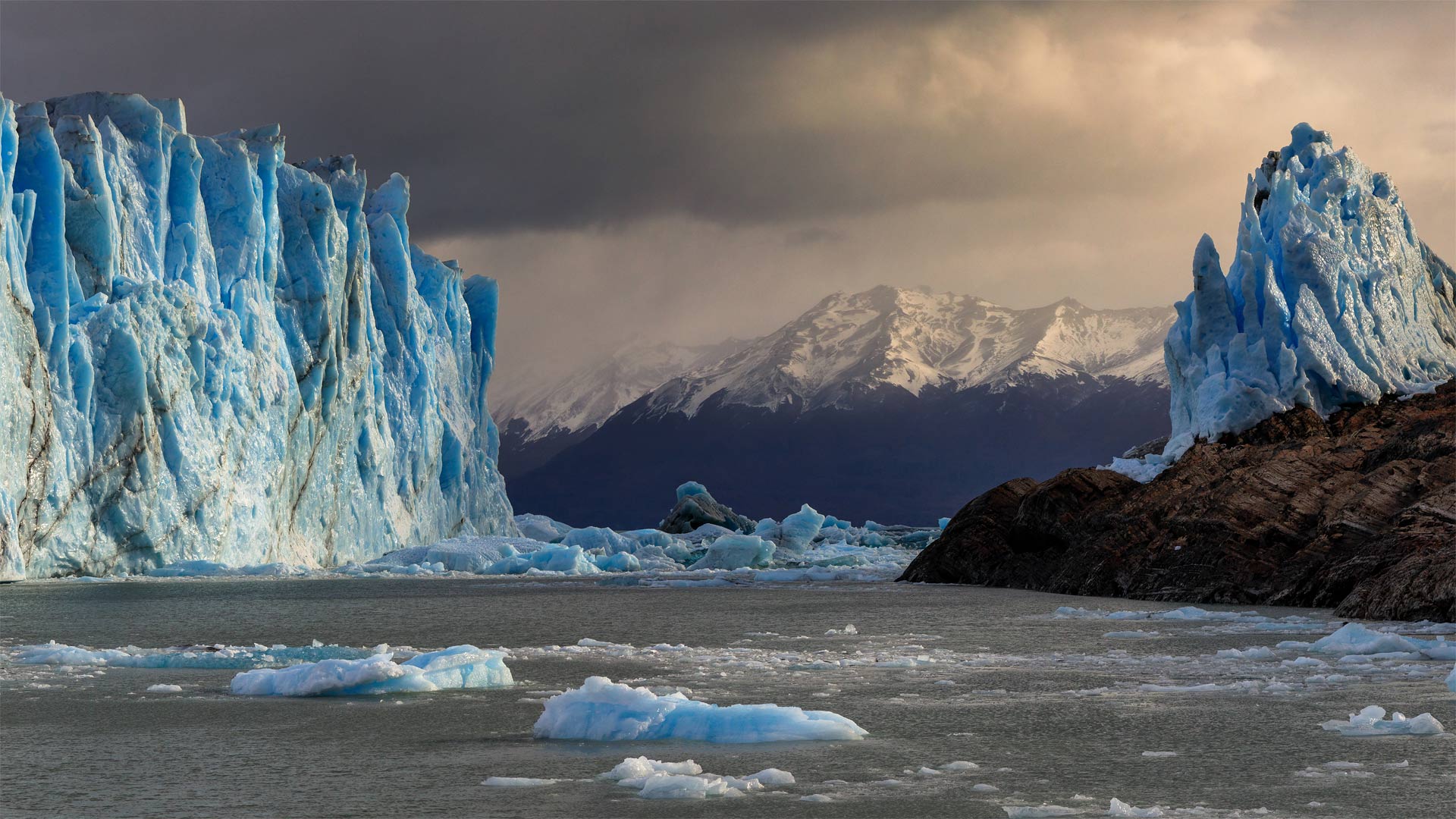
冰川国家公园中的佩里托莫雷诺冰川,阿根廷 Perito Moreno Glacier in Patagonia's Los Glaciares National Park, Argentina (© Juergen Schonnop/Getty Images)
The persistence of Perito Moreno
Yes, it's true that glaciers are shrinking, but not all of them. Perito Moreno, a low-lying glacier in southern Argentina, accumulates ice at about the same rate that it melts into chilly Argentino Lake. This equilibrium makes it one of the few glaciers worldwide that aren't losing mass to climate change.
Perito Moreno is an Argentine icon, partly for its unusual accessibility via the lake, the largest within the nation. Visitors to Los Glaciares National Park can boat or kayak out on ice-blue water for a better look—but they need to keep a safe distance as icebergs constantly calve from the glacier's face, creating huge splashes and waves.
佩里托·莫雷诺的坚持
是的,冰川确实在缩小,但不是全部。阿根廷南部的一座低洼冰川佩里托莫雷诺(Perito Moreno)积冰的速度与它融化到寒冷的阿根廷湖的速度差不多。这种平衡使它成为全球为数不多的不会因气候变化而失去质量的冰川之一。
佩里托·莫雷诺是阿根廷的一个标志,部分原因是它通过这个国家最大的湖泊不同寻常的可达性。到洛斯冰川国家公园的游客可以在冰蓝色的水面上划船或皮划艇,以获得更好的观赏效果,但他们需要保持安全距离,因为冰山不断地从冰川表面脱落,形成巨大的水花和海浪。
圣克鲁斯河,阿根廷巴塔哥尼亚 Santa Cruz River, Patagonia, Argentina (© Coolbiere Photograph/Getty Images)
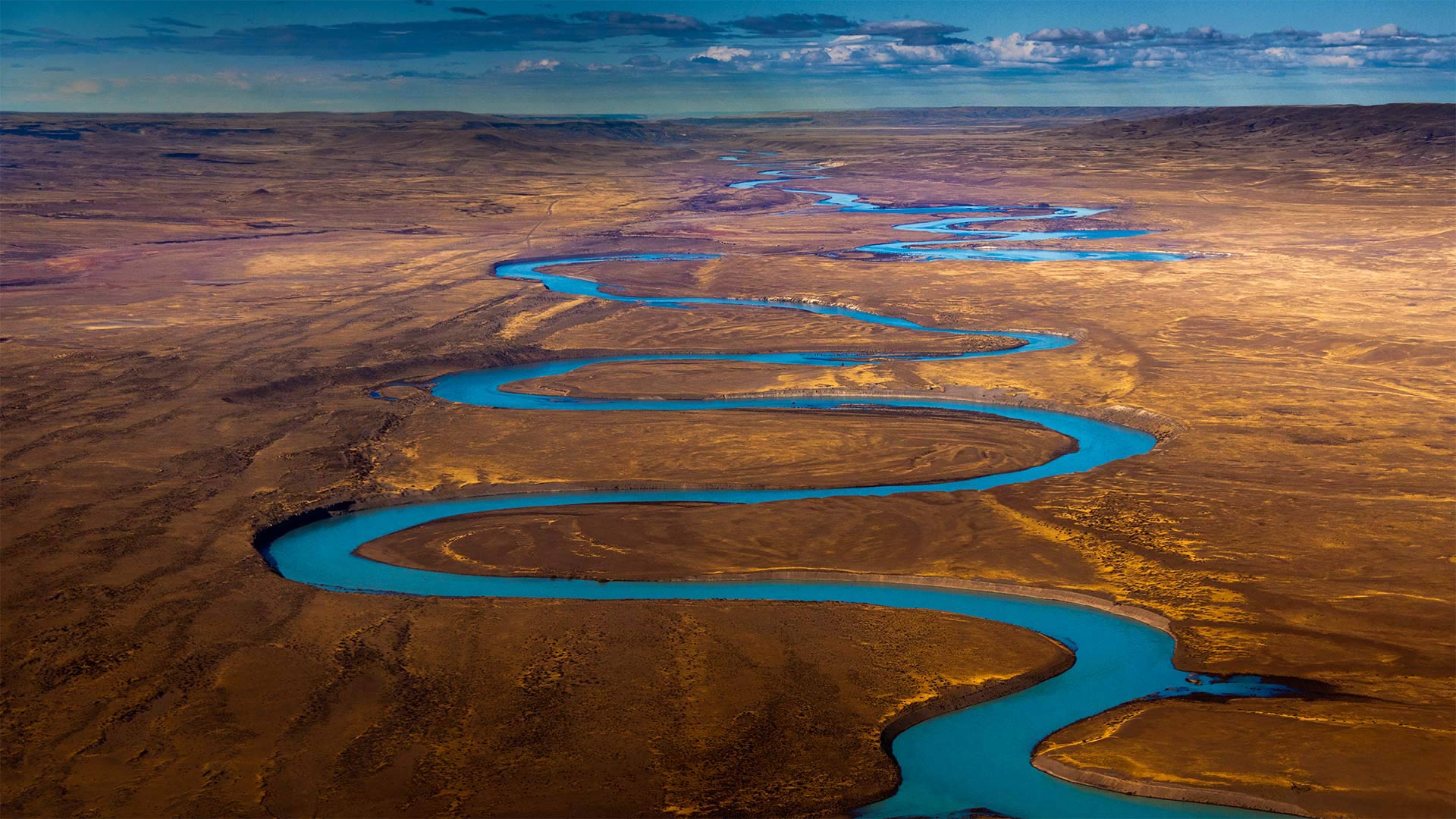
圣克鲁斯河,阿根廷巴塔哥尼亚 Santa Cruz River, Patagonia, Argentina (© Coolbiere Photograph/Getty Images)
Meandering through Patagonia
Squiggling east from the Andes mountains to the Atlantic Ocean, the mighty Santa Cruz river in Argentina's Patagonia region flows over some of South America's sparsest terrain. Over the centuries, some of history's most notable explorers have been drawn to the winding waterway: Ferdinand Magellan's 1520 expedition discovered its coastal delta, and Charles Darwin (on the same voyage that took him to the Galápagos Islands) studied the area's ecosystem during a grueling 1834 side-trip up the river. Even now, very few settlements exist along the 240-mile course of the Santa Cruz, considered the last major free-flowing river in Patagonia.
The river's many U-shaped bends, called meanders, are carved out gradually: When flow pressure isn't equal on both banks of a river, erosion tends to warp small bends into dramatic, sweeping curves over long periods of time. But the prospect of much swifter change looms over the Santa Cruz: A controversial hydroelectric dam project already underway downstream will potentially have a drastic impact on the entire river's hydrology and ecosystem.
